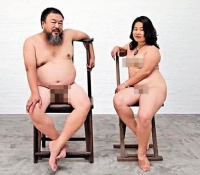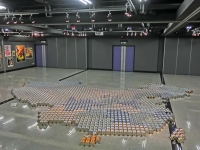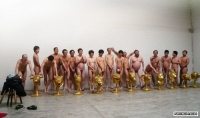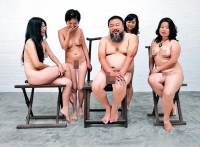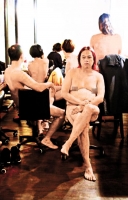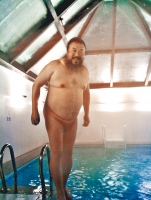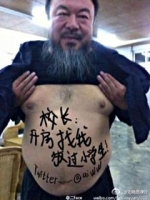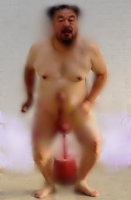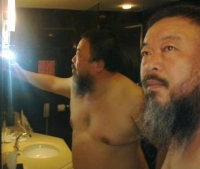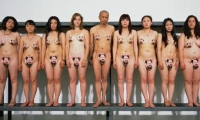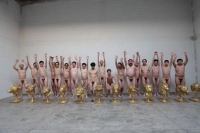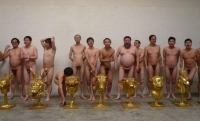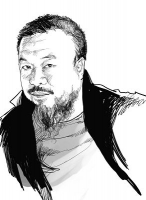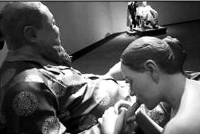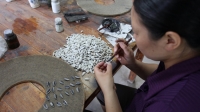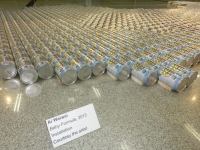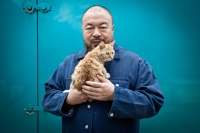| jíguàn: | běi jīng | ||
yuèdòuài wèi wèi Ai Weiweizài百家争鸣dezuòpǐn!!! | |||
AIWEIWEI jiǎn lì
1957 nián 8 yuè 28 rì shēng yú zhōng guó běi jīng
1978 nián běi jīng diàn yǐng xué yuàn
1981 nián parsonsSchoolofDesign,ArtStudentleague, měi guó niǔ yuē。
1994-1999 nián zhù biān chū bǎn qián wèi yì shù kān wù“ hēi pí shū” (1994)、 bái pí shū (1995)、 huī pí shū (1999) běi jīng。
1998-1999 nián“ zhōng guó yì shù wén jiàn kù” yì shù zǒng jiān
zhǎn lǎn
1979 nián dì yī jiè《 xīng xīng huà zhǎn》, zhōng guó běi jīng
1980 nián dì 'èr jiè《 xīng xīng huà zhǎn》, zhōng guó měi shù guǎn, běi jīng
1982 nián gè zhǎn, jiù jīn shān yà zhōu jī jīn huì huà láng, měi guó。
1986 nián《 qī gè zhōng guó yì shù jiā》 VorpalGallery, měi guó
《 zhōng guó xīn biǎo xiàn》 niǔ yuē shì shì lì huà láng, měi guó。
《 zhōng guó qián wèi yì shù》 VassarCollegcGallery
AlbanyUniversityArtGallery, měi guó。
1987 nián《 TheStaratHarvard》 FairbankCenter, HarvardUniversity, měi guó。
1988 nián gè zhǎn《 jiù xié · xìng 'ān quán》 měi guó niǔ yuē。
1989 nián《 TheStar: TenYear》 HanartGallery, xiāng gǎng, tái běi, bā lí。
1990 nián guó jì bǎn huà zhǎn, HanartGallery, tái běi。
1994 nián《 zhōng guó yì shù zhǎn》 dōng jīng huà láng, rì běn。
《 zhōng guó dāng dài yì shù zhǎn》 gē dé bǎo yì shù bó wù guǎn, ruì diǎn。
1995 nián《 Configura2》, dé guó
1996 nián《 bǐ dé · lù dé wéi xī shōu cáng zhǎn》, dé guó。
1997 nián《 jiāo diǎn》 zhōng、 rì、 hán xiàn dài yì shù zhǎn, hán guó
1999 nián dì 48 jiè wēi ní sī shuāng nián zhǎn, yì dà lì
2000 nián《 yī xī shuāng nián zhǎn》, fǎ guó
1999 nián《 chuàng xīn》, běi jīng yì shù wén jiàn
《 guān niàn hé chōu xiàng》, běi jīng yì shù wén jiàn
1999 nián kē lóng yì shù jié, dé guó
ài wèi wèi( 1957 nián 5 yuè 18 rì -), zhōng guó yì shù jiā, zhōng guó yì shù wén jiàn
ài wèi wèi chú cóng shì yì shù chuàng zuò, hái guān zhù wéi quán huó dòng, bìng duì zhōng guó nèi dì duō gè shè xián zhèng zhì fǔ bài 'ér yǐn fā de shì gù jìn xíng diào chá, bāo kuò dú nǎi fěn shì jiàn、 mén chuān dà dì zhèn zhōng yīn zhèng fǔ xīng jiàn xué xiào tōu gōng jiǎn liào, ér dǎo tā dǎo zhì dà liàng xué shēng sǐ wáng shì gù、 shēng yuán bèi pò hài de wéi quán rén shì děng。 yīn qí xíng dòng jí yán lùn céng shòu dào zhèng fǔ de ruǎn jìn hé bào lì duì dài。
2011 nián 4 yuè 3 rì, ài wèi wèi yú běi jīng bèi dāng jú kòu liú, dàn chāo guò fǎ dìng qī xiàn yī gè duō yuè réng wèi bèi qǐ sù, zhōng gòng tòu guò chuán méi zhǐ kòng 'ài wèi wèi shè xián táo shuì děng duō zhǒng bù dāng xíng wéi, hòu lái gōng 'ān jī guān shēng chēng chá míng 'ài wèi wèi shè xián jīng jì fàn zuì。 tā bèi kòu liú shì jiàn chù fā wài jiè guān zhù jí bù fēn rén de shēng yuán, yòu bù shǎo píng lùn rèn wéi tā bèi bǔ de yuán yīn shì tā cānyù wéi quán huó dòng jí pēng jī zhōng gòng yòu guān。 tóng nián 6 yuè 22 rì, ài wèi wèi huò dāng jú qǔ bǎo hòu shěn, hòu lái zhōng guó zhèng fǔ dāng jú chēng tā lòu shuì, wǎng hòu tā réng zhōu xuán yú bèi dāng jú zhǐ kòng jí jiān shì zhī jiān。
zǎo nián shēng huó
dì shí 'èr jiè wén xiàn zhǎn zhǎn pǐn,《 mó》
dì shí 'èr jiè wén xiàn zhǎn zhǎn pǐn,《 kè rén de zhù chù》 ài wèi wèi 1957 nián yú běi jīng chū shēng, wéi yǐ gù zhōng guó xiàn dài shī rén 'ài qīng yǔ gāo yīng zhī zǐ, qí qī lù qīng wéi huà jiā, jū yú běi jīng cǎo chǎng dì cūn。 zhōng gòng fā qǐ de fǎn yòu yùn dòng qī jiān, ài qīng yī jiā yú 1958 nián bèi liú fàng xīn jiāng bìng zài xīn jiāng shí hé zǐ jū zhù liǎo shí liù nián, hòu yú 1975 nián quán jiā fǎn huí běi jīng。
1978 nián rù dú běi jīng diàn yǐng xué yuàn, tóng qī de xué shēng bāo kuò zhōng guó dǎo yǎn chén kǎi gē yǔ zhāng yì móu。 1981 nián zhì 1993 nián 'ài wèi wèi zhù yào jū zhù zài měi niǔ yuē, bìng jiù dú niǔ yuē pà sēn shè jì xué yuàn, hòu yīn yī mén kè wèi tōng guò 'ér bèi xué xiào tíng zhǐ fā fàng jiǎng xué jīn, zuì hòu gèng lí kāi xué xiào 'ér chéng wéi fēi fǎ jū liú zhě bìng yǐ jiē tóu huà xiàng huò dǎ líng gōng。 tā suǒ hùn jì de niǔ yuē zì shēn gōng yù, chéng wéi xǔ duō zhōng guó yì shù jiā zài měi guó de zhōng zhuǎn zhàn, cǐ wài tā yì tóng shí chéng wéi yī wèi jī jí de jiē tóu kàng yì zhě, cānyù liǎo xǔ duō jiē tóu kàng yì huó dòng, bìng duō cì yǔ niǔ yuē jǐng chá fā shēng zhī tǐ chōng tū, yě céng pāi xià jǐng chá duì bié de kàng yì zhě shí shī guò dù bào lì de zhào piàn。 1987 nián zài měi guó jǔ bàn《 jiù xié、 xìng 'ān quán》 yì shù zhǎn, bèi yì píng jiā chēng wéi“ yǐn rén zhù mùdì xīn dá dá zhù yì”。 zài 1989 liù sì shì jiàn zhōng , huò dé“ liù sì xuè kǎ”。 dàn 1993 nián 4 yuè fù qīn 'ài qīng huàn bìng, tā fǎn huí běi jīng zhào gù fù qīn bìng fàng qì liǎo měi guó jū mín shēnfèn。
fǎn huí běi jīng yǐ hòu tā xié zhù chéng lì běi jīng dōng cūn, gāi dì chéng wéi hěn duō shí yàn yì shù jiā de jiā yuán。 tā chū bǎn liǎo yī xì liè sān běn de shū, míng wéi《 hēi pí shū》、《 bái pí shū》 hé《 huī pí shū》。 1999 nián 'ài wèi wèi zài běi jīng dōng běi bù de cǎo chǎng dì jiàn liǎo zì jǐ de gōng zuò shì hé fáng zǐ, zhè shì tā de dì yī gè jiàn zhù xiàng mù, tā cóng zhè shí hòu kāi shǐ cóng shì gèng duō de jiàn zhù xiàng mù bìng chéng lì liǎo míng wéi fā kè gōng zuò shì de jiàn zhù shì wù suǒ。
yì shù shēng yá
zǎo qī 1978 nián 'ài wèi wèi yǔ mǎ dé shēng、 wáng kè píng、 huáng ruì、 lǐ shuǎng、 zhōng 'ā chéng、 qū lěi lěi děng rén chuàng bàn zuì zhōng yú 1983 nián jiě sàn de xīng xīng huà huì, ài wèi wèi zhì jīn réng yòu cānyù xīng xīng de jí tǐ měi shù zhǎn, lì rú 1989 nián de《 xīng xīng huà huì shí nián zhǎn》 yǔ 2007 nián de《 yuán diǎn: xīng xīng huà huì huí gù zhǎn》。 1981 nián zhì 1993 nián zhù yào jū zhù zài měi guó niǔ yuē bìng céng jiù dú niǔ yuē pà sēn shè jì xué yuàn, zhè duàn shí qī shēn shòu dù shàng diān fù zhèng tǒng fēng gé de yǐng xiǎng, zhì zuò de yì shù pǐn dà duō shì yǐ xiàn chéng wù jiàn gǎi zhuāng de gài niàn zuò pǐn。 tā zài 1994 nián gèng wéi diàn shì jù《 běi jīng rén zài niǔ yuē》 dān rèn fù dǎo yǎn。
zhǎn lǎn 2000 nián shí yǔ féng bó yī zài shàng hǎi jǔ bàn“ bù hé zuò fāng shì” yì shù zhǎn。 tā de zuò pǐn《 tóng huà》、《 mó》 yú 2007 nián cān jiā dì shí 'èr jiè kǎ sài 'ěr wén xiàn zhǎn, qí zhōng《 mó》 bèi dà yǔ cuī huǐ, dàn 'ài wèi wèi méi yòu xiū fù, bìng rèn wéi dà zì rán de lì liàng lìng zuò pǐn gèng chū sè。 zài 2010 nián 'ài wèi wèi bèi yāo qǐng chuàng zuò yī gè zuò pǐn lái bǔ chōng dān mài gē běn hā gēn yīn zū jiè dào shàng hǎi cān jiā shì bó huì de měi rén yú diāo xiàng 'ér zào chéng de kòngwèi, tā jiàn zào liǎo yī gè néng xiàn chǎng zhí bō xiǎo měi rén yú shì bó huì qíng kuàng de bì lù diàn shì xì tǒng wǎng zhàn, lái biǎo dá zhōng guó réndōu chù zài mǒu zhǒng jiān shì zhī xià de zhēn shí shēng huó。 2010 nián 9 yuè 19 rì, ài wèi wèi yǔ zuǒ xiǎo zǔ zhòu cān jiā liǎo 2010 dà shēng zhǎn。
jiàn zhù 'ài wèi wèi zài jiàn zhù shè jì shàng chōng mǎn liǎo gè rén zhù yì de fēng gé, tā zài 1999 nián shè jì jí jiàn zào wèi yú běi jīng dōng wǔ huán wài cǎo chǎng dì cūn de 'ài wèi wèi gōng zuò shì, 2003 nián ruì shì de jiàn zhù shì wù suǒ hè 'ěr zuǒ gé hé dé méi lóng( Herzog&deMeuron) shè jì běi jīng guó jiā tǐ yù chǎng“ niǎo cháo” shí tā bèi pìn wéi gāi xiàng mùdì yì shù gù wèn, hái zài 2006 nián yú niǔ yuē hǎdé xùn hé gǔ qū shè jì yī suǒ sī rén zhù zhái。 2012 nián 2 yuè, lún dūn kěn xīn dùn gōng yuán( KensingtonGardens) xuān bù, yǐ yāo dé 2008 nián běi jīng 'ào yùn“ niǎo cháo” de shè jì zhě、 ài wèi wèi hé liǎng míng ruì shì shè jì shī zài dù xié shǒu, shè jì 'ào yùn hù wài chǎng guǎn, yù yì yán xù běi jīng 'ào yùn de jīng shén。
zhù zuò 1994 nián zhì 1999 nián zhù biān zhōng guó qián wèi yì shù kān wù《 hēi pí shū》、《 bái pí shū》、《 huī pí shū》。
jī fěng zhī zuò 'ài wèi wèi yì shù zuò pǐn《 yī hǔ bā nǎi tú》, bèi méi tǐ jiě dú wéi jī fěng zhōng gòng 'ér rě zhēng yì。 zuò pǐn zhōng de 'ài wèi wèi shǒu qiǎo miào dì zhē zhù xià tǐ, dài biǎo zhe“ dǎng zhōng yāng”( dǎng zhōng yāng); shuāng shǒu 'ān wěn dì zhì yú zuǒ xī shàng, biǎo míng jiān dìng de zuǒ qīng lì chǎng。 huà miàn zuì zuǒ de nǚ zǐ, dài zhe yǎn jìng zuò zài méi yòu kào bèi de yǐ zǐ, xiàng zhēng zhī shí fènzǐ yòu dì wèi、 yòu jià zǐ, dàn què kào bù zhù; ér tā bō nòng tóu fā, shǐ zhōng cè shēn xiàng zhe dǎng zhōng yāng, yě shuō míng zhī shí fènzǐ zài zěn me mài nòng, réng bèi zhèng fǔ qiān zhe zǒu。 zuì yòu de nǚ zǐ tǐ tài fēng yú, guà yù pèi、 dài shǒu biǎo, shì zī chǎn jiē jí; tā yòu dì wèi yě kào dé zhù, shuāng shǒu xiàng shēn tǐ yòu cè bǎi, dài biǎo“ yòu qīng” lì chǎng。 zài zhè fú huà lǐ, dǎng zhōng yāng yǔ zī chǎn jiē jí xiāng gé shèn yuǎn, hǎo bǐ tái miàn shàng de guān xì, dàn liǎng rén hái yòu lìng wài yī zhāng dān dú hé yǐng, zé xiàng zhēng bèi hòu de guān shāng gòu jié。 huà zhōng de duǎn fā nǚ zǐ yuán xiān méi yòu dì wèi, jǐn néng zhàn zhe péi xiào, dàn hòu lái bèi dǎng zhōng yāng lā qù kào zhe zuò, dài biǎo xīn wén méi tǐ shòu kòng zhì。 zhì yú cóng tóu dào wěi zhǐ néng zhàn zài yǐ hòu, shēn tǐ bèi zhē zhù zuì duō de, zé shì méi yòu dì wèi、 yě shí cháng bèi wú shì de nóng gōng jiē jí。 zhōng guó zuò jiā gù xiǎo jūn biǎo shì, gāi tú tài zhēn shí hé tài dà dǎn, zhēn shí dé méi yòu rèn hé yī sī yī lǚ de yǎn shì yǔ biān dǎo hén jì, shì dà dǎn yǔ qí duì yì shù de quán shì。
wéi quán zhī lù
diào chá mén chuān dà dì zhèn 2008 nián 5 yuè mén chuān dà dì zhèn fā shēng hòu, dà pī xiào shè dǎo tā zào chéng shù qiān shī shēng sǐ wáng, yùnàn xué shēng jiāzhǎng pēng jī xiào shè kě néng cún zài jiàn zhù wèn tí, zhì yí dāng jú wèihé zài tān tā de xiào shè zhōu wéi qí tā jiàn zhù wù què néng gòu jīng shòu dì zhèn de chōng jī。 2008 nián 5 yuè, ài wèi wèi zài qí xīn làng de bó kè lǐ lù xù gōng bù liǎo 2008 nián sì chuān mén chuān dà dì zhèn sǐ wáng de jù tǐ de xué shēng míng dān, dàn zhè xiē shù jù bù jiǔ hòu biàn bèi guǎn lǐ fāng shān chú。
2008 nián 12 yuè 5 rì 'ài wèi wèi fā qǐ liǎo gōng mín diào chá zhì yuàn zhě huó dòng, duì 512 dà dì zhèn yùnàn xué shēng de jù tǐ shù jù, rú; xué xiào、 xìng míng、 nián líng、 bān jí、 jiā tíng zhù zhǐ、 jiāzhǎng lián xì fāng shì děng jìn xíng diào chá, jié zhì 2010 nián 3 yuè, gōng mín diào chá gòng zhǎo dào 5212 míng yùnàn xué shēng míng dān。 2009 nián 10 yuè kāi shǐ, ài wèi wèi yǐ tā fā qǐ de“ gōng mín diào chá” de míng yì xiàng zhōng yāng、 sì chuān shěng jí、 xiàn shì jí yǐ jí jī jīn huì děng 100 duō jiā bù tóng zhèng fǔ jī gòu shēn qǐng gōng kāi 512 tiáo wán zhěng xìn xī, bāo kuò zāi qíng hé chá、 juān kuǎn shǐ yòng míng xì、 tān tā xiào shè diào chá bào gào、 yǐ jí yùnàn shī shēng jù tǐ qíng kuàng děng jìn wàn tiáo xìn xī, dàn què méi yòu dé dào rèn hé zhèng miàn huí fù。
shēng shòu wéi quán rén shì 2009 nián 8 yuè 12 rì, ài wèi wèi yǔ diào chá mén chuān dà dì zhèn yùnàn xué shēng xiào shè gōng chéng zhì liàng de zhì yuàn zhě děng rén, yìng sì chuān wéi quán rén shì tán zuò rén lǜ shī yāo qǐng 'ér zuò wéi zhèng rén qián wǎng chéng dū chū tíng。 jù chēng dāng tiān líng chén zài jiǔ diàn zāo dào chéng dū gōng 'ān de jū jìn jí 'ōu dǎ, gāi guò chéng bèi pāi shè chéng jì lù piàn《 lǎo mā tí huā》 bìng shàng chuán zhì wǎng luò。 9 yuè 14 rì 'ài wèi wèi zài dé guó mù ní hēi měi shù guǎn bù zhǎn qī jiān tóu tòng jiā jù bèi sòng dào dé guó mù ní hēi dà xué yī yuàn, hòu jīng zhěn duàn wéi“ nǎo chū xuè”。 tóng nián 11 yuè, ài wèi wèi de nǚ zhù shǒu cóng běi jīng dào rì běn dōng jīng chéng tián guó jì jī chǎng tàn wàng bìng cǎi fǎng yīn bèi shàng hǎi dāng jú jù jué fǎn guó 'ér zhì liú yú jī chǎng guǎn zhì qū nèi de wéi quán rén shì féng zhèng hǔ, bìng jiāng guò chéng jiǎn ji chéng jì lù piàn《 féng zhèng hǔ huí jiā》。 2010 nián 4 yuè 6 rì qián wǎng chéng dū jīn niú qū xī 'ān lù pài chū suǒ bào 'àn, yào qiú jǐng fāng duì qí zài 2009 nián 8 yuè 12 rì bèi 'ōu dǎ shì jiàn lì 'àn zhēn chá。 5 yuè 4 rì, ài wèi wèi gōng zuò shì wán chéng jì lù piàn《 měi hǎo shēng huó》 bìng shàng chuán wǎng luò。 gāi piàn jì lù liǎo féng zhèng hǔ huí jiā de gù shì。 5 yuè 6 rì, fā bù zhì zuò jìn liǎng nián de yáng jiā 'àn de quán chéng jì lù piàn,《 yī gè gū pì de rén》 jí qí xù jí《 wáng jìng méi》。 5 yuè 12 rì, fā bù jì niàn“ 512 dì zhèn yùnàn xué shēng” de《 niàn》。
gōng zuò shì tū zāo chāi chú 2010 nián 1 yuè 11 rì, ài wèi wèi zài shàng hǎi mǎ lù de yì shù gōng zuò shì zāo dào qiáng chāi, gāi gēn jù shàng hǎi jiā dìng qū mǎ lù zhèn de yǐn jìn yì shù jiā guī huá 'ér xīng jiàn de gōng zuò shì, zài jiàn zhù wán gōng bù jiǔ, tū rán jiē huò mǎ lù zhèn dāng jú tōng zhī, chēng qí wéi fǎn《 chéng xiāng guī huá fǎ》 jué dìng yú yǐ chāi chú。。 ài wèi wèi zài yī gè diàn huà cǎi fǎng zhōng tán dào, qiáng xíng chāi chú xíng wéi hé zhèng fǔ zhī qián de jǔ dòng wán quán bù yī zhì。 tā shuō:“ tā men bù jǐn pī zhǔn liǎo zhè gè gōng zuò shì, shèn zhì shì cháng zài yī cì zhēn duì zhè gè dì qū fā zhǎn de jiǎng huà zhōng, hái yòng wǒ zuò liǎo xuān chuán”。 fù zé xīng jiàn gōng zuò shì de lǚ héng zhōng rèn wéi, qiáng chāi yǔ 'ài wèi wèi zhuī chá zào chéng 6 sǐ 5 shāng de yáng jiā xí jǐng 'àn yòu guān。 ér jù zhōng yāng shè bào dào, yáng jiā xí jǐng 'àn fā shēng zài 2008 nián 7 yuè 1 rì de shàng hǎi shì zhá běi qū zhèng fǎ dà lóu, zào chéng 6 sǐ 5 shāng shì gù。 duì cǐ 'ài wèi wèi hái tè dì fā bù guò jiǎng shù yáng jiā 'àn quán bù guò chéng de jì lù piàn“ yī gè gū pì de rén”,“ xī wàng rén men bù yào yí wàng”。
wǎng luò píng xuǎn bèi dàn huà 2011 nián 1 yuè 26 rì, xīn làng wǎng zài qí shōu cáng pín dào tuī chū“ 2010 xīn làng yì shù quán lì bǎng” píng xuǎn huó dòng, ài wèi wèi chéng wéi wǎng yǒu tóu piào de dì yī míng, dàn 1 yuè 27 rì líng chén zǎo shàng liù shí zuǒ yòu cǐ píng xuǎn yè miàn tū rán xiāo shī 'ér bèi“ 2010 nián dù yì shù quán lì bǎng zuì jù wǎng luò rén qì yì shù jī gòu píng xuǎn” dài tì, 2 yuè 16 rì, zài“ 2010 nián dù yì shù quán lì bǎng zuì jù wǎng luò rén qì yì shù jī gòu píng xuǎn” zhōng, wǎng yǒu tóu piào 'ài wèi wèi suǒ shè jì de sān yǐng táng, lìng qí dé piào shù kuài sù zēngzhǎng dá dào 5000 duō piào 'ér wèi jū bǎng shǒu, rán 'ér dào liǎo dāng rì wǎn jiān 8 diǎn tóu piào jié zhǐ qián, zhù bàn fāng xīn làng wǎng tōu tōu cuàn gǎi tóu piào shù mù, jiāng yuán běn jiā dé de 3400 duō piào gǎi wéi 5000 duō piào, ér sān yǐng táng de 5000 duō piào gǎi wéi 4500 duō piào, yòu wǎng yǒu diàn xún xīn làng, dàn xīn làng yuán gōng biǎo shì bù zhī qíng yě jù jué tòu lù xiáng qíng。 suí hòu zài 2 yuè 21 rì, yú 798 yì shù qū pǐn huà láng jǔ xíng de bān jiǎng diǎn lǐ zhōng 'ài wèi wèi yǔ zhù shǒu dào xiàn chǎng rù kǒu chù kàng yì, hái zài niú bó shàng fā biǎo liǎo wén zhāng, guò wǎng 2009 nián liù sì 'èr shí zhōu nián qián xī, ài wèi wèi de xīn làng、 sōu hú hé wǎng yì bó kè tóng shí bèi chè dǐ guān bì, dàn 'ài wèi wèi zài fáng huǒ cháng chéng zhī wài de niú bó guó jì bó kè wèi shòu dào yǐng xiǎng。
cānyù yóu xíng shì wēi 2010 nián 2 yuè 22 rì, běi jīng cháo yáng qū jīn zhǎn xiāng cháng diàn cūn de chuàng yì zhèng yáng yì shù qū yì zāo qiáng zhì chāi qiān, yòu mù jī zhě chēng 200 duō míng shēnfèn bù míng de rén dào yuán qū nèi dǎ shāng yì shù jiā、 zá huài wù pǐn, bāo kuò rì běn yì shù jiā yán jiān xián zài nèi de 8 rén bèi dǎ shāng, bìng qiě yòu wā jué jī huǐ huài fáng wū。 ài wèi wèi dāng tiān xià wǔ yǔ jìn 20 míng yì shù jiā lā qǐ xiě zhe“ gōng mín quán lì” jí“ yán chéng xiōng shǒu chú hēi dǎ 'è” de héng fú dào běi jīng cháng 'ān jiē yóu xíng shì wēi, yuán lái tā men yù dìng yào zǒu dào tiān 'ān mén guǎng chǎng, bù guò zài jù lí guǎng chǎng liǎng gōng lǐ chù jiù bèi gǎn dào de dà pī jūn jǐng hé gōng 'ān rén yuán lán zǔ, dì 'èr tiān《 huán qiú shí bào》 yīng wén bǎn hǎn yòu dì duì shì jiàn jìn xíng liǎo bào dào, dàn bào dào gāi shì jiàn de jì zhě wén tāo zài 20 tiān hòu bèi kāi chú。
bèi jū liú wǎng hòu zhī lì chéng 2010 nián 11 yuè, ài wèi wèi de zhī chí zhě shù bǎi rén xīng qī tiān jù jí zài qí jí jiāng bèi qiáng chāi de shàng hǎi gōng zuò shì, cān jiā“ hé xiè” yàn, ér 'ài wèi wèi běn rén réng bèi dāng jú ruǎn jìn zài běi jīng jiā zhōng, wú fǎ chéngháng。
2011 nián 4 yuè 3 rì, ài wèi wèi yuán běn jìhuà jīng yóu xiāng gǎng zhuǎn fēi tái běi, chóu bèi 10 yuè zài tái wān jǔ bàn de yī gè zhǎn lǎn, dàn zài běi jīng shàng jī qián bèi biān jiǎn rén yuán dài zǒu, gōng 'ān bìng sōu chá liǎo 'ài wèi wèi gōng zuò shì, bǎ bā míng gōng zuò rén yuán dài zhì cháo yáng qū nán gāo pài chū suǒ wèn huà。 tóng shí xīn làng wēi bó shàng yǐ“ ài wèi wèi” wéi guān jiàn zì sōu suǒ xì tǒng xiǎn shì“ gēn jù xiāng guān fǎ lǜ fǎ guī hé zhèng cè, sōu suǒ jiēguǒ wèi yú xiǎn shì”, tóng shí xīn làng píng bì liǎo yòu guān 'ài wèi wèi bèi jū liú de wēi bó nèi róng。
2011 nián 4 yuè 11 rì lù qīng gào sù měi lián shè jì zhě chēng jǐng fāng wèi gào zhī tā 'ài wèi wèi jū liú dì diǎn、 lǐ yóu jí shí qī, bìng yú 4 yuè 10 rì sōu chá liǎo gōng zuò shì, dài zǒu liǎo yī xiē wén dàng、 diàn nǎo hé yìng pán。
2011 nián 5 yuè 16 rì, lǜ shī liú xiǎo yuán huì jiàn liǎo 'ài wèi wèi de mǔ qīn gāo yīng jí qī zǐ lù qīng, lù qīng zài 5 yuè 15 rì zài mì mì guān yā dì diǎn jiàn dào liǎo 'ài wèi wèi, bìng chēng 'ài wèi wèi shēn tǐ zhuàng kuàng liáng hǎo, wèi bèi guān zài yī yuàn huò jiān yù, dàn méi yòu jìn yī bù shuō míng 'ài wèi wèi de jū zhù tiáo jiàn。 lù qīng cāi cè 'ài wèi wèi zài wài bèi jiān shì jū zhù。 tóng yī tiān, zhōng guó wài jiāo bù fù bù cháng chēng 'ài wèi wèi shì jiàn yìng xìn rèn zhōng guó sī fǎ。
2011 nián 5 yuè 20 rì,《 wén huì bào》 yuán yǐn xīn huá shè de xiāo xī chēng“ ài wèi wèi shè jīng jì fàn zuì chá míng”。 2011 nián 5 yuè 21 rì, ài wèi wèi de jiě jiě gāo gé fǎn bó liǎo guān fāng duì tā de tōu lòu shuì zhǐ kòng。
2011 nián 6 yuè 11 rì, ài wèi wèi bèi kòu liú dì 69 tiān。 ài wèi wèi de qī zǐ lù qīng jí shī zōng de fā kè wén huà fā zhǎn yòu xiàn gōng sī de yuán gōng de jiā shǔ zài cì lián míng zhì xìn gōng 'ān bù、 běi jīng shì gōng 'ān jú、 běi jīng shì jiǎn chá yuàn、 běi jīng shì jì wěi jí běi jīng shì zhèng fǎ wěi。
2011 nián 6 yuè 22 rì, zhōng gòng guān fāng méi tǐ xīn huá shè bào dào běi jīng shì gōng 'ān jī guān jiàn yú 'ài wèi wèi rèn zuì tài dù hǎo、 huàn yòu màn xìng jí bìng děng yuán yīn, qiě qí duō cì zhù dòng biǎo shì yuàn yì jī jí bǔ jiǎo shuì kuǎn, yǐ fǎ duì 'ài wèi wèi qǔ bǎo hòu shěn。 ài wèi wèi duì méi tǐ biǎo shì“ zì jǐ hěn kāi xīn huí dào jiā lǐ, dàn yóu yú réng zài bǎo shì jiē duàn, wú fǎ jiē shòu méi tǐ cǎi fǎng”。 yīng guó huáng jiā guó jì shì wù yán jiū suǒ( ChathamHouse) de zhōng guó wèn tí zhuān jiā luó dé lǐ kè · wéi( RodericWye) rèn wéi zhōng guó zhèng fǔ shì fàng 'ài wèi wèi yǔ zhōng guó zǒng lǐ wēn jiā bǎo fǎng wèn 'ōu zhōu méi yòu lián xì。
2011 nián 6 yuè 23 rì, ài wèi wèi biǎo shì, yīn wéi zài qǔ bǎo hòu shěn qī jiān, jiē xià lái yī nián nèi tā bù bèi yǔn xǔ lí kāi běi jīng, yě bù néng jiē shòu cǎi fǎng, bù néng shàng wǎng。 zhōng guó wài jiāo bù fā yán rén hóng lěi biǎo shì, zhēn duì 'ài wèi wèi de diào chá jiāng jì xù jìn xíng, ài wèi wèi bù yǔn xǔ lí kāi běi jīng。 lù qīng zài jiē shòu měi lián shè diàn huà cǎi fǎng shí biǎo shì dāng jú bù yǔn xǔ 'ài wèi wèi tán jí bèi jū jìn hé shì fàng de yuán yīn, qiě 'ài wèi wèi réng shòu dào biàn yī jǐng chá jiān shì gēn zōng。
2011 nián 6 yuè 24 rì, bólín dé guó wài jiāo zhèng cè xié huì de zhuān jiā sāng dé shī nài dé( EberhardSandschneider) rèn wéi, ài wèi wèi huò shì yòu kě néng shì zhōng guó lǐng dǎo céng miàn xiàng zuì jìn fǎng wèn de dōng dào zhù dé guó yǔ yīng guó suǒ zuò chū de hé jiě zī tài。
2011 nián 6 yuè 28 rì, liú xiǎo yuán lǜ shī tòu lù dāng jú yào 'ài wèi wèi bǔ jiāo zǒng shù yuē 200 wàn měi yuán de shuì kuǎn jí fá kuǎn。 ài wèi wèi běn rén jù jué duì cǐ shì biǎo tài。
2011 nián 7 yuè 15 rì, ài wèi wèi zài jiē shòu zì yóu yà zhōu diàn tái de cǎi fǎng shí, shǒu cì huí yìng liǎo zhōng guó zhèng fǔ dāng jú chēng tā jiù tōu lòu shuì 'àn“ rèn zuì” de shuō fǎ。 tā shuō :“ wǒ jué dé rèn zuì yào jiàn lì zài duì wǒ shí xíng dài bǔ hé qǐ sù de chéng xù shàng, rán 'ér zhè gè chéng xù cóng lái méi yòu wán chéng guò, méi yòu zhēn zhèng de bèi dài bǔ huò zhě qǐ sù guò, suǒ yǐ wǒ jué dé shì yī jiàn hěn huá jī de shì qíng。 " tán jí tōu shuì 'àn jiàn shí, tā shuō :“ suǒ yòu guān yú shuì wù 'àn de nèi róng dōushì bù qīng xī de, ér qiě yě bù néng jìn xíng gōng kāi de tīng zhèng, suǒ yǐ wǒ jué dé zhè fāng miàn shì hěn míng liǎo de。”
2011 nián 11 yuè 1 rì, ài wèi wèi shōu dào běi jīng shì shuì wù jú de fá kuǎn dān, é dù gāo dá 1500 wàn rén mín bì, xiàn qī 15 tiān bǔ jiǎo shuì kuǎn。
2011 nián 11 yuè 2 rì, ài wèi wèi de mǔ qīn gāo yīng hé dì dì 'ài dān yǐ 'ài qīng gù jū wéi dǐ yā wù qiān shǔ dǐ yā shēng míng。 suí hòu yòu wǎng yǒu fā qǐ“ chéng wéi 'ài wèi wèi zhài zhù” xíng dòng, biǎo shì yào wéi 'ài wèi wèi jiè kuǎn。
2011 nián 11 yuè 7 rì, ài wèi wèi de zhī chí zhě zài wǎng shàng fā qǐ jiè qián yùn dòng, xié zhù 'ài wèi wèi dù guò nán guān, jù 'ài wèi wèi shuō, wǎng yǒu tōng guò gè zhǒng fāng shì“ jiè qián” gěi tā, qí zhōng bāo kuò yóu zhèng huì kuǎn、 yínháng zhuǎn zhàng děng, shèn zhì yòu rén yè jiān gé zhe qiáng wǎng tā jiā lǐ rēng qián。 ài wèi wèi chéng nuò“ měi yī fēn qián dū hái”。 ài wèi wèi chēng zì jǐ jué bù huì yòng wǎng yǒu de qián jiǎo shuì, tā jiāng bǎ zhè xiē qián fàng zài yī gè gōng kāi 'ān quán de dì fāng, yǐ hòu yòu jī huì jiāng quán bù tuì hái。 zhōng gòng guān fāng méi tǐ《 huán qiú shí bào》 dāng tiān fā biǎo shè píng chēng“ ài wèi wèi ‘ jiè qián hái shuì ’ gǎo dé tài xì jù xìng”。 ài wèi wèi de mǔ qīn gāo yīng qiǎn zé zhōng gòng dāng jú xiàng 'ài wèi wèi zhuī jiǎo shuì kuǎn。
2011 nián 11 yuè 13 rì, jié zhì dāng rì, ài wèi wèi cóng zhī chí zhě nà lǐ huò dé de“ jiè kuǎn” yǐ jīng dá dào 869 wàn yuán rén mín bì, dàn běi jīng shuì wù bù mén jù jué jiē shòu 'ài wèi wèi yǐ fǎ jiǎo nà de bǎo zhèng jīn。
2011 nián 11 yuè 18 rì, ài wèi wèi de zuì míng zhōng chú liǎo shuì wù wèn tí wài, tā yǐ qián yǔ sì míng nǚ xìng wǎng yǒu yī qǐ pāi de yī zhāng luǒ tǐ zhào piàn《 yī hǔ bā nǎi tú》, bèi yǐ“ wǎng shàng chuán bō yín huì zhào piàn” zhī míng zāo jǐng fāng diào chá。
2012 nián 03 yuè 29 rì, běi jīng shì dì shuì jú chēng, jīng fù yì jué dìng 'ài wèi wèi shàng sù shī bài, àn jiàn bù jǔ xíng gōng kāi tīng zhèng, wéi chí duì yuán yòu de shuì fá jué dìng, fá kuǎn 1,500 wàn yuán rén mín bì。 ài wèi wèi zài tuī tè( Twitter) shàng zhǐ,“ guó jiā shuō nǐ tōu lòu shuì nǐ jiù tōu lòu shuì liǎo。 zhōng guó de xíng zhèng chéng xù shì wéi zhèng zhì fú wù de, shuì wù chéng wéi gōng 'ān wéi wěn de gōng jù”。
2012 nián 4 yuè 3 rì, ài wèi wèi shàng nián dāng tiān bèi jū bǔ, tā zài jiā zhōng 'ān zhuāng liǎo sì gè shè xiàng tóu, 24 xiǎo shí tōng guò weiweicam.com wǎng zhàn duì wài zhí bō tā de shēng huó, jìn xíng lìng lèi kàng yì, zài guān yuán yào qiú xià, ài wèi wèi de zhí bō zài lì shí gòng 47 xiǎo shí 9 fēn zhōng hòu bèi pò guān bì。 ài huò shì hòu jìn yī nián réng rán bèi jiān shì jū zhù, dāng jú zài tā wèi yú běi jīng cǎo chǎng dì de zhù suǒ 100 mǐ fàn wéi nèi 'ān zhuāng chāo guò 15 gè bì lù diàn shì, jìn zhǐ tā lí jīng。
zhōng guó zhèng fǔ jí qí méi tǐ píng lùn yǔ zhēng yì guān fāng méi tǐ
2011 nián 4 yuè 6 rì líng chén, xīn huá shè yīng wén bǎn fā biǎo duǎn xìn yǐn shù gōng 'ān bù mén xiāo xī zhǐ“ ài wèi wèi yīn wéi shè xián jīng jì fàn zuì zhèng yǐ fǎ jiē shòu diào chá”, bù guò bào dào hěn kuài jiù shān chú, dàn xiāng gǎng qīn zhōng gòng bào zhāng《 wén huì bào》 réng kān dēng liǎo chū lái。 zhōng gòng guān fāng bào zhǐ《 rén mín rì bào》 qí xià de《 huán qiú shí bào》 yú 4 yuè 6 rì fā biǎo shè píng“ fǎ lǜ bù huì wéi tè lì dú xíng zhě wān qū”, yú 4 yuè 18 rì fā biǎo shè píng“ xī fāng gěi 'ài wèi wèi de bì hù tài tè shū”。 4 yuè 15 rì, xiāng gǎng《 wén huì bào》 fā biǎo wén zhāng“ ài wèi wèi zhēn miàn mù: wǔ wán yì shù jiā-- wǔ dú jù quán”, zhǐ 'ài wèi wèi wéi yì shù, wán zhèng zhì, wán fǎ lǜ, wán gǎn qíng, wán liáng zhī, wén zhāng duì qí xíng wéi dǐ huǐ。 bào dào yòu zhǐ 'ài wèi wèi shè xián táo lòu shuì、 chónghūn zuì hé wǎng luò sàn bō yín huì wù pǐn zuì bèi dāng jú kòng zhì zhèng zài jiē shòu diào chá。 5 yuè 12 rì,《 huán qiú shí bào》 fā biǎo shè píng“ mén chuān, qiān miàn zhōng guó de yī gè zhēn shí biǎo qíng”, shè píng zhōng chēng“ zhōng guó yǐ shè xián jīng jì fàn zuì dài bǔ 'ài wèi wèi, jìn zhǐ jiē tóu“ mò lì huā gé mìng”, què yǐn qǐ xī fāng yú lùn de yī piàn zhēng yì”。 6 yuè 24 rì,《 huán qiú shí bào》 fā biǎo shè píng“ xī fāng zǒng xiǎng gěi zhōng guó fǎ yuàn‘ pī tiáo zǐ’”。
zhōng guó zhèng fǔ
2011 nián 4 yuè 7 rì líng chén, zhōng guó guān fāng xīn huá shè fā bù jiǎn duǎn yīng wén xiāo xī shuō, ài wèi wèi yīn wéi“ shè xián jīng jì fàn zuì” zhèng zài jiē shòu jǐng fāng diào chá, suí hòu, xīn huá wǎng duì gāi xiāo xī jìn xíng shān chú, dàn yòu wǎng mín duì cǐ xiāo xī jìn xíng jié tú cún zhèng。 suí hòu, zhōng guó wài jiāo bù fā yán rén hóng lěi yě duì cǐ xiāo xī jìn xíng zhèng shí, chēng bèi kòu chá de zhù míng yì shù jiā 'ài wèi wèi shè xián jīng jì fàn zuì 'àn bèi diào chá。
zhēng yì
xiāng gǎng shí shì píng lùn yuán liú ruì shào rèn wéi, guān fāng xīn huá shè fā biǎo zhēn duì 'ài wèi wèi de wén zhāng shì shì tú mèi hēi tā。 rú liú xiǎo bō děng bù tóng zhèng jiàn rén shì rù zuì qián, dū shòu dào wén zhāng mèi hēi, zhè zhǒng yì shì zhōng guó zhèng fǔ guàn yòng de jìliǎng, tā chēng zhōng guó zhèng fǔ yìng ràng 'ài wèi wèi yòu kàng biàn de jī huì。《 rén mín rì bào》 qí xià de《 huán qiú shí bào》 yīng wén bǎn, yú 2011 nián 06 yuè 27 rì fā biǎo shè lùn, zhǐ hú jiā、 liú xiǎo bō、 ài wèi wèi děng rén suǒ yǐ huò xī fāng chēng xǔ, shì yuán yú xī fāng duì zhōng guó zhèng fǔ de piān jiàn, bìng fēi jī yú duì zhōng guó shè huì jí shì jiè hé píng zuò chū gòng xiàn。 wén zhāng yòu chēng, ài wèi wèi děng rén jūn wú yī lì wài fǎn duì zhōng guó de zhèng zhì tǐ zhì, yīn cǐ cái bèi xī fāng chēng xǔ, bìng fēi yīn duì zhōng guó shè huì jí shì jiè hé píng yòu suǒ gòng xiàn, zuì zhōng huì bèi xī fāng shè huì yí wàng
qiān lián
chāo xí zhēng yì
zuì xiān zài xiāng gǎng shàng huán jiē tóu chū xiàn de“ shuí zài hài pà 'ài wèi wèi?” xiào xiàng tú yā
xiāng gǎng yì shù jiā jiāng 'ài wèi wèi tóu xiàng tóu shè dào jǐng shǔ dà lóu biǎo dá bù mǎn
xiāng gǎng fā qǐ de 1001 zhāng yǐ chēng 'ài wèi wèi jí bèi bǔ yì jiàn rén shì de xíng dòng 2011 nián 04 yuè, zài 'ài wèi wèi bèi bǔ hòu, xīn huá shè fā biǎo wén zhāng zhǐ qí shè xián jīng jì fàn zuì zhèng jiē shòu diào chá, wén zhāng yòu zhǐ 'ài wèi wèi zài dé guó zhǎn chū de zuò pǐn shì chāo xí yì shù jiā yuè lù píng de lìng zuò pǐn。 dàn yuè lù píng zài xīn làng wēi bó fā biǎo 'èr qiān duō zì gōng kāi shēng míng, tí mù shì“ qǐng xīn huá shè bié làn yòng wǒ de míng zì”。 shēng míng zhǐ zì jǐ de míng zì bèi xīn huá shè zhāo mù chéng wéi yī kē qí zǐ, qí běn rén bìng bù qíng yuàn。 2011 nián 4 yuè 17 rì, yuè lù píng zài wǎng zhì chēng shòu dào kǒnghè, tā yòu biǎo shì shì qíng běn shì yì shù jiè xuán 'àn, yǔ zhèng zhì wú guān, xīn huá shè rú cǐ xuàn rǎn, duì 'ài wèi wèi hěn bù gōng píng。
tú yā kàng yì cháo 2011 nián 4 yuè 13 rì, xiāng gǎng shàng huán jiē tóu chū xiàn duō gè bái sè qī yóu de 'ài wèi wèi xiào xiàng tú yā, bàng biān gèng yòu zhōng yīng wén zì jù xiě dào“ shuí zài hài pà 'ài wèi wèi?”, gū jì mù de shì kàng yì dāng jú jū bǔ 'ài wèi wèi。 jǐng fāng bǎ zhè gè xíng shì huǐ huài 'àn 'àn jiàn, jiāo yóu zhuān mén diào chá yán zhòng zuì xíng de zhòng 'àn zǔ lái chù lǐ, shì jiàn yǐn qǐ liǎo xiāng gǎng bù fēn rén shì zhì yí jǐng fāng de zhèng zhì zhōng lì xìng。 yòu píng lùn rèn wéi zài xiāng gǎng suí chù kě jiàn guǎng gào tú yā, dàn zhè cì jǐng fāng chū dòng zhòng 'àn zǔ diào chá, nán táo zhèng zhì dǎ yā zhī xián, zhǐ huì nòng qiǎo fǎn zhuō。, ér shì jiàn méi yòu píng xī, qí hòu zài duō chù wèi zhì chū xiàn tóng lèi tú yā, yòu rén shèn zhì jiāng 'ài wèi wèi de xiào xiàng tóu shè dào jiě fàng jūn zhù gǎng bù duì zǒng bù、 wān zǎi jǐng chá zǒng bù děng jiàn zhù wù de wài qiáng jí jǐng chē děng xuàn xiè。
wài jiè píng lùn jí shēng yuán 2011 nián 4 yuè 4 rì, shēn zài xī ní de jì suàn jī rén gōng zhì néng bó shì hòu yán jiū yuán ruǎn jí jiàn lì liǎo“ wǒ 'ài wèi wèi iLoveWeiwei” bó kè。
2011 nián 4 yuè 23 rì, ér zài xiāng gǎng, chāo guò yī qiān míng gǎng rén yóu xíng yào qiú zhōng gòng dāng jú shì fàng 'ài wèi wèi。
2011 nián 5 yuè 2 rì, shì 'ài wèi wèi bèi dāng jú kòu yā yī gè yuè de rì zǐ。 xiāng gǎng mín zhù pài hào zhào mín zhòng zài wéi duō lì yà gōng yuán yǐ bǎi chū yī gè jù dà de“ qiú” zì, xiàng zhēng zhōng guó xiàn zài shì shì jiè shàng zuì dà de qiú láo, yào qiú zhōng guó dāng jú shì fàng 'ài wèi wèi yǐ jí bāo kuò liú xiǎo bō zài nèi de suǒ yòu zhèng zhì yì yì rén shì。
2011 nián 5 yuè 30 rì, zài téng xùn de QQ liú lǎn qì jiè shào wǎng yè zhōng chū xiàn“ aiww”、“ shì fàng”、“ 64” zì yàng( jié tú), shè jì zhě yòng shí fēn yǐn huì de fāng shì kàng yì guān fāng dài bǔ 'ài wèi wèi, suí hòu téng xùn jiāng wǎng yè shàng de "#aiww#" gǎi wéi liǎo "#love#"。
2011 nián 6 yuè 9 rì, ài wèi wèi bù fēn zhuān fǎng zài ruì shì rì nèi wǎ zhào kāi de lián hé guó rén quán lǐ shì huì huì yì shàng shǒu cì gōng kāi。
2011 nián 6 yuè 22 rì, xiāng gǎng xīn shì jì chū bǎn shè de fù zé rén bào pǔ rèn wéi 'ài wèi wèi tū rán bèi shì fàng kě néng hé mǎ shàng dào lái de zhōng guó gòng chǎn dǎng jiàn dǎng 90 zhōu nián yòu guān。
wén yì jiè
2011 nián 3 yuè 29 rì, yóu jì zhě jiān jì lù piàn zhì zuò zhě AlisonKlayman pāi shè de jì lù piàn《 Who'safraidofAiWeiwei?》( shuí zài hài pà 'ài wèi wèi) zài měi guó gōng gòng diàn shì tái( PBS) Frontline bō chū。 AlisonKlayman yú 4 yuè 4 rì zhuàn wén“ ài wèi wèi bù shì zuì fàn”
。
2011 nián 4 yuè 3 rì, měi guó zhù míng jiàn zhù shī LebbeusWoods zài zì jǐ de wǎng zhì shàng shēng míng“ bù zài jiē shòu zhōng guó de rèn hé xiàng mù, zhí dào 'ài wèi wèi bèi shì fàng”。
2011 nián 5 yuè 15 rì, xiāng gǎng yòu yì shù gōng zuò zhě jì zǎo qián de shēng yuán 'ài wèi wèi yóu xíng hòu, zài cì jǔ xíng yóu xíng huó dòng yào qiú dāng jú shì fàng 'ài wèi wèi hé qí tā yì jiàn rén shì, gāo hǎn“ shì fàng suǒ yòu zhèng zhì fàn” děng kǒu hào。
2011 nián 5 yuè 28 rì, yīng guó zuò jiā HariKunzru zhuàn wén shēng yuán 'ài wèi wèi。
2011 nián 6 yuè 4 rì, zhōng guó liú wáng zuò jiā bèi lǐng zài zhōng zhèng jì niàn táng yòng 1001 zhāng yǐ zǐ pái chū“ ài wèi wèi” sān gè dà zì。
2011 nián 6 yuè 15 rì, zhù míng de yīng guó diāo sù jiā 'ā ní shī · kǎ pǔ 'ěr xuān bù qǔ xiāo tā yuán dìng zài běi jīng jǔ bàn de zhǎn lǎn, yǐ kàng yì zhōng guó zhèng fǔ guān yā 'ài wèi wèi。
2011 nián 6 yuè 23 rì, zhù míng de yīng guó diāo sù jiā 'ā ní shī · kǎ pǔ 'ěr biǎo shì, ài wèi wèi huò jiǎ shì lìng tā zhèn fèn, dàn shì kǎ pǔ 'ěr bìng bù xiāng xìn 'ài wèi wèi táo shuì。
zhèng jiè
měi guó 2011 nián 4 yuè 21 rì, zhù huá dà shǐ hóng bó péi zài shí dài zá zhì shí dài bǎi dà rén wù píng xuǎn zhōng wéi 'ài wèi wèi zhuàn wén。
zhōng huá mín guó 2011 nián 4 yuè 6 rì, xíng zhèng yuàn lù wěi huì zhù wěi lài xìng yuán zài lì fǎ yuàn biǎo shì 'ài wèi wèi cǐ xíng fǎng tái mùdì dān chún 'ér yǔ zhèng zhì huó dòng wú guān, hūyù dà lù fāng miàn lì jí shì fàng 'ài wèi wèi。 2011 nián 6 yuè 4 rì, zhōng huá mín guó zǒng tǒng mǎ yīng jiǔ fā biǎo liù sì shì jiàn jì niàn zhuān wén, bìng tí dào xī wàng dà lù dāng jú zǎo rì shì fàng liú xiǎo bō、 ài wèi wèi。
dé guó wài cháng wéi sī tè wéi lè、 yīng guó wài jiāo dà chén wēi lián · hēi gé、 fǎ guó wài jiāo bù、 měi guó guó wù yuàn yào qiú zhōng gòng dāng jú lì jí shì fàng 'ài wèi wèi。
guó jì zǔ zhì
2011 nián 4 yuè 4 rì, guó jì tè shè zǔ zhì yà tài dì qū zhù rèn shān mǔ · zhā lǐ fèi( SamZarifi) zhǐ ài wèi wèi méi yòu cānyù rèn hé“ mò lì huā” yùn dòng, tā zāo dào jū bǔ sì hū méi yòu rèn hé lǐ yóu。
2011 nián 6 yuè 22 rì, guó jì tè shè zǔ zhì yà tài dì qū fù zhù rèn kǎi sè lín · bā pò( CatherineBaber) rèn wéi zhōng guó zhèng fǔ shì fàng 'ài wèi wèi shì wéi liǎo zhuǎn yí pī píng。 tóng shí guó jì tè shè zǔ zhì hūyù zhōng guó zhèng fǔ shì fàng 'ài wèi wèi gōng zuò shì de qí tā sì míng bèi fēi fǎ jū jìn de zhù shǒu wén tāo、 hú míng fēn、 liú zhèng gāng hé zhāng jìngsōng。
2011 nián 6 yuè 23 rì, guó jì tè shè zǔ zhì zài cì yào qiú zhōng guó zhèng fǔ biǎo míng 'ài wèi wèi gōng zuò shì zhù shǒu de xià luò。
2011 nián 4 yuè 6 rì, rén quán guān chá zǔ zhì yào qiú zhōng guó zhèng fǔ yìng lì jí shì fàng yì shù jiā、 pī píng jiā 'ài wèi wèi, bìng tíng zhǐ zì yì dǎ yā yì yì rén shì。
2011 nián 6 yuè 22 rì, rén quán guān chá zǔ zhì yà zhōu chàng dǎo cù jìn shì wù bù zhù rèn, suǒ fěi · lǐ chá sēn( SophieRichardson) rèn wéi zhōng guó zhèng fǔ jū bǔ zhī hòu yòu shì fàng 'ài wèi wèi shì chū yú zhèng zhì mùdì, zhōng guó zhèng fǔ shì fàng 'ài wèi wèi yě shì guó jì yú lùn yā lì qǐ xiào guǒ de yī gè lì zǐ。
róng yù 2010 nián 3 yuè, ài wèi wèi yú bǐ lì shí gēn tè dà xué de zhèng zhì yǔ shè huì xué xì huò dé róng yù bó shì xué wèi。 9 yuè huò bān dé guó kǎ sài 'ěr shì gōng mín jiǎng“ lǐ xìng lēng jìng” jiǎng; 12 yuè xiāng gǎng tiān wén xué huì huì cháng yáng guāng yǔ chéng gōng xiàng guó jì tiān wén xué huì shēn qǐng jiāng xiǎo xíng xīng 83598 mìng míng wéi 'ài wèi wèi xīng。 tóng nián yīng guó《 yì shù píng lùn》 zá zhì bǎ 'ài wèi wèi píng wéi“ xiàn dài yì shù jiè zuì yòu yǐng xiǎng lì de 100 rén” zhōng de dì shí sān míng。
2011 nián 6 yuè, yīng guó huáng jiā yì shù xué yuàn shòu yú 'ài wèi wèi wéi róng yù yuàn shì 7 yuè, dé guó bólín yì shù dà xué shòu yú 'ài wèi wèi jiào shòu zhí wèi。
2011 nián 10 yuè 13 rì, ài wèi wèi bèi yīng guó《 yì shù guān chá》 zá zhì píng wéi quán qiú zuì yòu yǐng xiǎng lì yì shù rén。
xiāng guān zhù zuò AiWeiwei:WorksBeijing1993 – 2003
AiWeiweiSpeak
AiWeiwei'sBlog:Writings,Interviews,andDigitalRants,2006-2009
AiWeiwei
ArtandCulturalPolicyinChina
AiWeiwei/Herzog&DeMeuron:Beijing,Venice,London
Becoming:ImagesofBeijingsAirTerminal3byAiWeiwei
shēng chǎn mó shì, tòu shì zhōng guó dāng dài yì shù( InProductionMode,ContemporaryArtinChina)
cǐ shí cǐ dì
Life and workAi Weiwei's father was Chinese poet Ai Qing, who was denounced during the Anti-Rightist Movement and in 1958 sent to a labour camp in Xinjiang with his wife, Gao Ying. Ai Weiwei was one year old at the time and lived in Shihezi for 16 years. In 1975 the family returned to Beijing. Ai Weiwei is married to artist Lu Qing.
In 1978, Ai enrolled in the Beijing Film Academy and attended school with Chinese directors Chen Kaige and Zhang Yimou. In 1978, he was one of the founders of the early avant garde art group the "Stars", together with Ma Desheng, Wang Keping, Huang Rui, Li Shuang, Zhong Acheng and Qu Leilei. The group disbanded in 1983, yet Ai participated in regular Stars group shows, The Stars: Ten Years, 1989 (Hanart Gallery, Hong-Hong and Taipei), and a retrospective exhibition in Beijing in 2007:Origin Point (Today Art Museum, Beijing).
From 1981 to 1993, he lived in the United States, mostly in New York, creating conceptual art by altering readymade objects. He studied at Parsons School of Design and at the Art Students League of New York. At the same time, Ai became fascinated by blackjack card games and frequented Atlantic City casinos. He is still regarded in gambling circles as a top tier professional blackjack player according to an article published on blackjackchamp.com.
In 1993, Ai returned to China after his father became ill. He helped establish the experimental artists' Beijing East Village and published a series of three books about this new generation of artists: Black Cover Book (1994), White Cover Book (1995), and Gray Cover Book (1997).
Ai Weiwei's contribution to the Documenta 12 in Kassel 2007Ai Weiwei is its Artistic Director of China Art Archives & Warehouse (CAAW), which he co-founded in 1997. This contemporary art archive and experimental gallery in Beijing concentrated on experimental art from the People's Republic of China, initiates and facilitates exhibitions and other forms of introductions inside and outside China. The building which houses it was designed by Ai in 2000.
In 1998, Ai moved to Caochangdi, in the northeast of Beijing, and built a studio house – his first architectural project. Due to his interest in architecture, he founded the architecture studio FAKE Design, in 2003. In 2000, he co-curated the art exhibition Fuck Off with curator Feng Boyi in Shanghai, China.
In 2006, Ai and HHF Architects designed a private residence in upstate New York for collectors Christopher Tsai and André Stockamp. According to the New York Times, the Tsai Residence is divided into four modules and the details are "extraordinarily refined". In 2009, the Chicago Athenaeum Museum of Architecture and Design selected the home for its International Architecture Awards, one of the world's most prestigious global awards for new architecture, landscape architecture, interiors and urban planning. In 2010, Wallpaper magazine nominated the Tsai Residence for its Wallpaper Design Awards category: Best New Private House. A detached guesthouse to the Tsai Residence, also designed by Ai and HHF Architects, was completed after the main house and, according to New York Magazine, looks like a "floating boomerang of rusty Cor-Ten steel."
Ai Weiwei's Fountain of Light (2007) is a 7m high tower of steel and crystals, reinterpreting Vladimir Tatlin's Monument to the Third International.
On 15 March 2010, Ai took part in Digital Activism in China, a discussion hosted by The Paley Media Center in New York with Jack Dorsey (founder of Twitter) and Richard MacManus.
ExhibitionsAi's artwork has been exhibited in Australia, Europe, North and South America. Solo exhibitions include Stiftung DKM, Duisburg (2010); Museum of Contemporary Craft, Portland (2010); Arcadia University Gallery, Glenside (2010); Mori Art Museum, Tokyo (2009); Haus der Kunst, Munich (2009); Three Shadows Photography Art Center, Beijing (2009); Sherman Contemporary Art Foundation, Cambelltown Arts Center, Sydney (2008); Groninger Museum, Groningen (2008).
Ai’s work was included in the 48th Venice Biennale in Italy (1999), 1st Guangzhou Triennale in China (2002), 1st Montpellier Biennial of Chinese Contemporary Art in France (2005), The 2nd Guangzhou Triennial (2005), Busan Biennial in Korea (2006), The 5th Asia-Pacific Triennial of Contemporary Art in Australia (2006), Documenta 12 in Germany (2007), Liverpool Biennial International 08 in the United Kingdom (2008), 2010 Venice Architecture Biennale and the 29th Sao Paulo Biennial in Brazil (2010).
Sunflower Seeds, 2010Fairytale is the title of Ai's contribution for Documenta 12 in 2007. For this project Ai brought 1001 people from all over China to the city of Kassel in Germany. They were chosen through an open invitation he posted on his blog. Ai even designed clothes, luggage and a temporary home in an old textile factory. He let them wander around the city during the exhibition time of three months. The participants were divided into five groups that each stayed in Kassel for eight days. According to Philip Tinari the primary design object here is not the clothing or suitcases but the participants' experiences, even their spirits. During the exhibition his monumental outdoor sculpture titled Template, made of wooden doors and windows from destroyed Ming and Qing Dynasty houses (1368–1911), collapsed after a storm. In 2008 he curated the architecture project Ordos 100 in Ordos City, Inner Mongolia. He invited 100 architects from all over the world (29 countries) to participate in this project.
Ai curated the exhibition The State of Things, together with Belgian artist Luc Tuymans. It was shown at the Centre for Fine Arts in Brussels from 18 October 2009 to 10 January 2010 and at the National Art Museum in Beijing from 1–30 May 2010. From October 2009 to January 2010 Ai exhibited So Sorry at Haus der Kunst in Munich, Germany. This solo exhibition showed Ai’s largest retrospective to date. The title refers to the thousands of apologies expressed recently by governments, industries, and financial corporations worldwide in an effort to make up for tragedies and wrongdoings – though often withhout shouldering the consequences or the desire to acknowledge let alone repair. Saying sorry – or not saying it – is in the headlines everywhere and thus also in China. For this show Ai created the installation Remembering on Haus der Kunst's façade. It was made out of 9000 children's backpacks. They spell out the sentence 'She lived happily for seven years in this world' in Chinese characters. This is a quote from a mother whose child died in the Sichuan earthquake in 2008. Ai said: "The idea to use backpacks came from my visit to Sichuan after the earthquake in May 2008. During the earthquake many schools collapsed. Thousands of young students lost their lives, and you could see bags and study material everywhere. Then you realize individual life, media, and the lives of the students are serving very different purposes. The lives of the students disappeared within the state propaganda, and very soon everybody will forget everything."
Template (2007) after collapseOn 25 July 2009 Ai opened his solo show According to What? at Tokyo's Mori Art Museum, Japan. This exhibition presented 26 works, most made over the past decade.
In December 2009, Ai had a small exhibition at the Comme des Garcons store in Hong Kong.
In February 2010, Ai Weiwei: Dropping the Urn, the first exhibition by Ai to travel outside New York City in the United States, opened at Arcadia University Art Gallery. The exhibition traveled to the Museum of Contemporary Craft in 2010, and the Knoxville Museum of Art and the Victoria and Albert Museum, London, in 2011. Included in the exhibition were iconic works by Ai including a Chinese figure in a Johnnie Walker liquor bottle (Untitled, 1993) and a Coca-Cola vase (Coca-Cola vase, 1997) from the collection of Christopher Tsai and André Stockamp.
From March to September 2010, Ai exhibited Barely Something, an exhibition curated by Roger M. Buergel, the director of Documenta12, at the Museum DKM in Duisburg, Germany.
In October 2010, Sunflower Seeds was installed at the Tate Modern Turbine Hall, London. The work consists of one hundred million porcelain "seeds," each individually hand-painted in the town of Jingdezhen by 1,600 Chinese artisans, and scattered over a large area of the exhibition hall. The artist was keen for visitors to walk across and roll in the work to experience and contemplate the essence of his comment on mass consumption, Chinese industry, famine and collective work. However, on 16 October, Tate Modern stopped people from walking on the exhibit due to health liability concerns over the porcelain dust. In February 2011, a 220-pound (100 kg) pile from Sunflower Seeds sold for $559,394 (well above its high estimate of $195,000) at Sotheby's in London.
Despite the artist's absence, Circle of Animals/Zodiac Heads opened on 4 May 2011, at the Pulitzer Fountain outside the Plaza Hotel in New York City. The heads were also on display at Somerset House in London from 12 May – 26 June 2011. The heads copy 18th century heads in the gardens of the Old Summer Palace, or Yuanmingyuan, near Beijing. They were ransacked by British and French troops during the Second Opium War of 1860, some of them resurfacing in 2000. A Guggenheim curator read Ai's words, "Without freedom of speech there is no modern world, just a barbaric one."
Ai's work is included in numerous public collections, among others the Los Angeles County Museum of Art, and the Museum of Contemporary Art, San Diego. On 20 April 2011, Ai was appointed Visiting Professor of the Berlin University of the Arts.
For the first time outside of China, his photographs of his time in New York City from 1983 to 1993 are featured in an exhibition presented by Asia Society. The earliest photographs are from 1983, while he was living in the Williamsburg neighborhood of Brooklyn. In 1985, he moved to Manhattan’s Lower East Side, where he lived in two different apartments until he returned to China in 1993 to be with his ailing father. The exhibition includes images of the poets Allen Ginsberg, Gu Cheng, and Bei Dao. The exhibition, showcasing 227 photos, opened on 29 June and lasted until 14 August 2011; It then took place at Martin Gropius Bau in Berlin from 15 October 2011 to 18 March 2012. Another exhibition this year Ai Weiwei: Dropping the Urn at the Victoria and Albert Museum from 15 October 2011 – 18 March 2012 featured a selection of ceramic works including Coca Cola Vase and a pile of sunflower seeds. In his ceramic works Ai angages with issues as the loss of historic material culture due to rapid modernization as well as broader themes including perceptions of value, mass production, globalization and the concepts of 'real' and 'fake'.
Awards and NominationsIn March 2010, Ai received an Honorary Doctorate Degree from the Faculty of Politics and Social Science, University of Ghent, Belgium.
In September 2010 he received Das Glas der Vernunft (The Prism of Reason), Kassel Citizen Award, Kassel, Germany.
Ai was ranked 13th in ArtReview's guide to the 100 most powerful figures in contemporary art: Power 100, 2010. Ai is now on top of ArtReview's guide to the 100 most powerful figures in contemporary art: Power 100, 2011.
In December 2011, he was one of four runners-up in Time's Person of the Year award.
Beijing National Stadium
The Beijing National Stadium at night during the 2008 Summer OlympicsAi was commissioned as the artistic consultant for design, collaborating with the Swiss firm Herzog & de Meuron, for the Beijing National Stadium for the 2008 Summer Olympics, also known as the "Bird's Nest." Although ignored by the Chinese media, he had voiced his anti-Olympics views. He later distanced himself from the project, saying, "I've already forgotten about it. I turn down all the demands to have photographs with it," saying it is part of a "pretend smile" of bad taste. In August 2007 he also accused those choreographing the Olympic opening ceremony, including Steven Spielberg and Zhang Yimou, of failing to live up to their responsibility as artists. Ai said "It's disgusting. I don't like anyone who shamelessly abuses their profession, who makes no moral judgment." In February 2008, Spielberg withdrew from his role as advisor to the 2008 Summer Olympics. When asked why he participated in the designing of the Bird's Nest in the first place, Ai replied "I did it because I love design."
Sichuan earthquake student casualties investigationOn 15 December 2008, Ai supported an investigation, started by another Chinese artist, into student casualties in the 2008 Sichuan earthquake. The investigation aimed to compile a list of students killed in the earthquake by 12 May 2009, the earthquake's first anniversary. As of 14 April 2009, the list had accumulated 5,385 names. Ai published the collected names as well as numerous articles documenting the investigation on his blog which was shut down by Chinese authorities in May 2009. He also posted his list of names of schoolchildren who died on the wall of his office at FAKE Design in Beijing.
Ai suffered headaches and claimed he had difficulty concentrating on his work since returning from Chengdu in August 2009, where he was beaten by the police for trying to testify for Tan Zuoren, a fellow investigator of the shoddy construction and student casualties in the earthquake.
On 14 September 2009, Ai was diagnosed to be suffering internal bleeding in a hospital in Munich, Germany, and the doctor arranged for emergency brain surgery. The cerebral hemorrhage is believed to be linked to the police attack.
According to the Financial Times, in an attempt to force Ai to leave the country, two accounts used by him had been hacked in a sophisticated attack on Google in China dubbed Operation Aurora, their contents read and copied; his bank accounts were investigated by state security agents who claimed he was under investigation for "unspecified suspected crimes".
Shanghai studio controversyIn November 2010, Ai was placed under house arrest by the Chinese police. He said this was to prevent the planned party marking the demolition of his newly built Shanghai studio.
The building was designed and built by Ai upon encouragement and persuasion from a "high official [from Shanghai]" as part of a new cultural area designated by Shanghai Municipal authorities; Ai would have used it as a studio and to teach architecture courses. But now Ai has been accused of erecting the structure without the necessary planning permission and a demolition notice has been ordered, even though, Ai said, officials had been extremely enthusiastic, and the entire application and planning process was "under government supervision". According to Ai, a number of artists were invited to build new studios in this area of Shanghai because officials wanted to create a cultural area.
On 3 November 2010 Ai said the government had informed him two months earlier that the newly completed studio would be knocked down because it was illegal. Ai complained that this was unfair, as he was "the only one singled out to have my studio destroyed." The Guardian reported Ai saying Shanghai municipal authorities were 'frustrated' by documentaries on subjects they considered sensitive: two of the better known ones featured Shanghai resident Feng Zhenghu, who lived in forced exile for three months in Narita Airport, Tokyo; another well known documentary focused on Yang Jia, who murdered six Shanghai police officers.
In the end, the party took place without Weiwei's presence; his supporters feasted on river crab, an allusion to "harmony", and a euphemism used to jeer official censorship. Ai was released from house arrest the next day.
Like other activists and intellectuals, Ai was prevented from leaving China in late 2010. Ai suggested that the authorities wanted to prevent him from attending the ceremony in December 2010 to award the 2010 Nobel Peace Prize to fellow dissident Liu Xiaobo. Ai said that he had not been invited to the ceremony, and was attempting to travel to South Korea for a meeting when he was told that he could not leave for reasons of national security.
In the evening of 11 January 2011, Ai's studio was demolished in a surprise move by the local government.
2011 arrest
South China Morning Post reports that Ai received at least two visits from the police, the last being on 31 March – three days before his detention – apparently with offers of membership to the Chinese People's Political Consultative Conference. A staff member recalled that Ai had mentioned receiving the offer earlier, "[but Ai] didn't say if it was a membership of the CPPCC at the municipal or national level, how he responded or whether he accepted it or not."
On 24 February, amid an online campaign for Middle East-style protests in major Chinese cities by overseas dissidents, Ai posted on his Twitter account: "I didn’t care about jasmine at first, but people who are scared by jasmine sent out information about how harmful jasmine is often, which makes me realize that jasmine is what scares them the most. What a jasmine!"
The caption (草泥马挡中央, "grass mud horse covering the middle") to Ai's self-portrait sounds almost the same in Chinese as 肏你妈党中央, "Fuck your mother, the Communist party central committee".On 3 April, Ai was arrested at Beijing Airport just before catching a flight to Hong Kong and his studio facilities were searched. A police contingent of approximately 50 officers came to his studio, threw a cordon around it and searched the premises. They took away laptops and the hard drive from the main computer; along with Ai, police also detained eight staff members and Ai's wife, Lu Qing. Police also visited the mother of Ai's two year-old son. While state media originally reported on 6 April that Ai was arrested at the airport because "his departure procedures were incomplete," the Chinese Ministry of Foreign Affairs said on 7 April that Ai was arrested under investigation for alleged economic crimes. Then, on 8 April, police returned to Ai's workshop to examine his financial affairs. On 9 April, Ai's accountant, as well as studio partner Liu Zhenggang and driver Zhang Jingsong, disappeared, while Ai's assistant Wen Tao has remained missing since Ai's arrest on 3 April. Ai's wife said that she was summoned by the Beijing Chaoyang district tax bureau, where she was interrogated about his studio's tax on 12 April.
Response to Ai's arrestSee also: Free Ai Weiwei street art campaign
Analysts and other activists said Ai had been widely thought to be untouchable, but Nicholas Bequelin from Human Rights Watch suggested that his arrest, calculated to send the message that no one would be immune, must have had the approval of someone in the top leadership. International governments, human rights groups and art institutions, among others, have called for Ai's release, while Chinese officials have yet to notify Ai's family of his whereabouts.
State media started describing Wei as a 'deviant and a plagiarist' in early 2011. The China Daily subsidiary, the Global Times editorial on 6 April 2011 attacked Wei, saying "Ai Weiwei likes to do something 'others dare not do.' He has been close to the red line of Chinese law. Objectively speaking, Chinese society does not have much experience in dealing with such persons. However, as long as Ai Weiwei continuously marches forward, he will inevitably touch the red line one day." Two days later, the journal scorned Western media for questioning Ai's charge as a "catch-all crime", and denounced the use of his political activism as a "legal shield" against everyday crimes. It said "Ai's detention is one of the many judicial cases handled in China every day. It is pure fantasy to conclude that Ai's case will be handled specially and unfairly." Frank Ching expressed in the South China Morning Post that how the Global Times could radically shift its position from one day to the next was reminiscent of Alice in Wonderland.
Tate Modern in London, home to Ai's 'Sunflower Seeds' exhibition, put a large sign on their exterior that reads "Release Ai Weiwei"Michael Sheridan of The Times suggested that Ai had offered himself to the authorities on a platter with some of his provocative art, particularly photographs of himself nude with only a toy alpaca hiding his modesty – with a caption『草泥马挡中央』 ("grass mud horse covering the middle"). The term possesses a double meaning in Chinese: one possible interpretation was given by Sheridan as: "Fuck your mother, the party central committee".
Ming Pao in Hong Kong reacted strongly to the state media's character attack on Ai, saying that authorities had employed “a chain of actions outside the law, doing further damage to an already weak system of laws, and to the overall image of the country.” Pro-Beijing newspaper in Hong Kong, Wen Wei Po, announced that Ai was under arrest for tax evasion, bigamy and spreading indecent images on the internet, and vilified him with multiple instances of strong rhetoric. Supporters said "the article should be seen as a mainland media commentary attacking Ai, rather than as an accurate account of the investigation."
The United States and European Union protested Ai's detention. The international arts community also mobilised petitions calling for the release of Ai: "1001 Chairs for Ai Weiwei" was organized by Creative Time of New York that calls for artists to bring chairs to Chinese embassies and consulates around the world on 17 April 2011, at 1 pm local time "to sit peacefully in support of the artist's immediate release." Artists in Hong Kong, Germany and Taiwan demonstrated and called for Ai to be released.
One of the major protests by U.S. museums took place on 19 and 20 May when the Museum of Contemporary Art San Diego organized a 24-hour silent protest in which volunteer participants, including community members, media, and museum staff, occupied two traditionally styled Chinese chairs for one-hour periods. The 24-hour sit-in referenced Ai’s sculpture series, Marble Chair, two of which were on view and were subsequently acquired for the Museum’s permanent collection.
The Solomon R. Guggenheim Foundation and the International Council of Museums, which organised petitions, said they had collected more than 90,000 signatures calling for the release of Ai. On 13 April 2011, a group of European intellectuals led by Václav Havel had issued an open letter to Wen Jiabao, condemning the arrest and demanding the immediate release of Ai. The signatories include Ivan Klíma, Jiří Gruša, Jáchym Topol, Elfriede Jelinek, Adam Michnik, Adam Zagajewski, Helmuth Frauendorfer; Bei Ling (Chinese:贝岭), a Chinese poet in exile drafted and also signed the open letter.
On 16 May 2011, the Chinese authorities allowed his wife to visit him briefly. Liu Xiaoyuan, his attorney and personal friend, reported that Wei was in good physical condition and receiving treatment for his chronic diabetes and hypertension; he was not in a prison or hospital but under some form of house arrest.
He is the subject of the 2012 documentary film Ai Weiwei: Never Sorry, directed by American filmmaker Alison Klayman, which received a special jury prize at the 2012 Sundance Film Festival and will open the Hot Docs Canadian International Documentary Festival, North America’s largest documentary festival, in Toronto on April 26, 2012.
ReleaseOn 22 June 2011, the Chinese authorities released Ai on bail after close to three months' detention on charges of tax evasion. Beijing Fake Cultural Development Ltd., a company Ai controlled, had allegedly evaded taxes and intentionally destroyed accounting documents. State media also reports that Ai was granted bail takes on account of Ai's "good attitude in confessing his crimes", willingness to pay back taxes, and his chronic illnesses. According to the Chinese Foreign Ministry, he is prohibited from leaving Beijing without permission for one year.
Ai's supporters widely viewed his detention as retaliation for his vocal criticism of the government. On 23 June 2011, professor Wang Yujin of China University of Political Science and Law stated that the release of Ai on bail shows that the Chinese government could not find any solid evidence of Ai's alleged "economic crime".
On 24 June 2011, Ai told a Radio Free Asia reporter that he was thankful for the support of the Hong Kong public, and praised Hong Kong's conscious society. Ai also mentioned that his detention by the Chinese regime was hellish (Chinese: 九死一生), and stressed that he is forbidden to say too much to reporters.
After his release, his sister gave some details about his detention condition to the press, explaining that he was subjected to a kind of psychological torture: he was detained in a tiny room with constant light, and two guards were set very close to him at all times, and watched him constantly.
In November, Chinese authorities were again investigating Ai and his associates, this time under the charge of spreading pornography. Lu was subsequently questioned by police, and released after several hours though the exact charges remain unclear.
Unpaid taxes and finesIn June 2011, the Beijing Local Taxation Bureau demanded a total of over 12 million yuan (US $1.85 million) from Beijing Fake Cultural Development Ltd in unpaid taxes and fines, and accorded three days to appeal the demand in writing. According to Ai's wife, Beijing Fake Cultural Development Ltd has hired two Beijing lawyers as defense attorneys. Ai's family state that Ai is neither the chief executive nor the legal representative of the design company, which is registered in his wife’s name." Lawyer-friend Liu Xiaoyuan has initiated an internet donation (or 'loan') campaign to help Ai to pay the unpaid taxes. They have reportedly received 1 million yuan.
Lawyers acting for Ai submitted an appeal against the fine in January 2012; the Chinese government subsequently agreed to conduct a review.

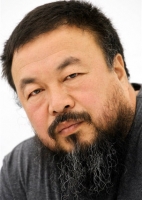
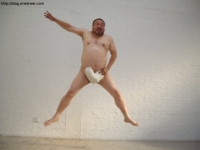
![回顧] 艾未未最近作品 [回顧] 艾未未最近作品
diǎnjītúpiànchákànxiángqíng](http://oson.ca/upload/images11/cache/c9cb0022ed0fc24534cb8c7b2ebafba0.jpg)

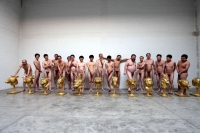
![藝術看客]藝術是個意外評艾未未的
diǎnjītúpiànchákànxiángqíng](http://oson.ca/upload/images11/cache/bf8b3cec1ab38acd768f6d589291df5e.jpg)
